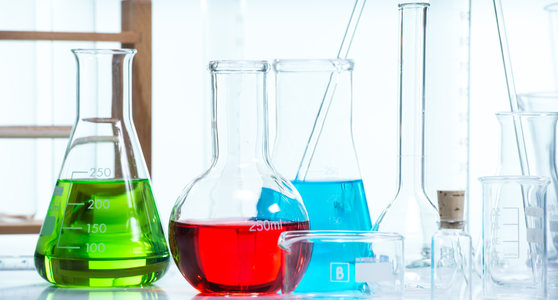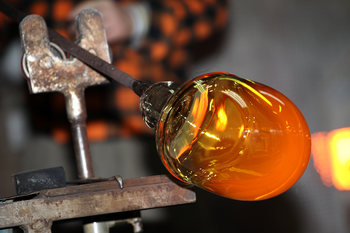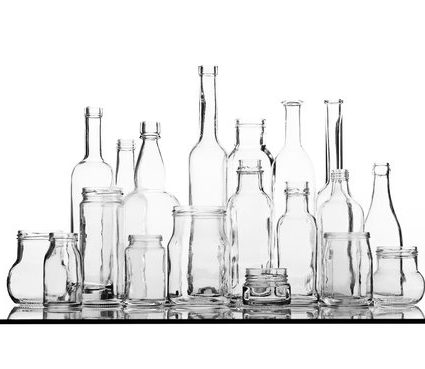Glass plays a very important role in our everyday lives. It is an extremely useful material, one we have been using for more than 3000 years. As quoted by Doug Main in his article in The Atlantic “Without glass, the world would be unrecognizable” (12). Do you know what glass is made of and how many different types of glass there are?
Quick Navigation
What is glass?
Glass brings light to our day through the windows in our houses or the light globes in our rooms. It protects us from the elements, provides vessels to store our food and drink, brings interactivity to our phone screens, and transports information through fiber-optic cables. Glass is important in our homes, our cars, and our offices.


If you check the dictionary glass has a few different meanings. It mostly refers to the hard, brittle, transparent substance made of silica, soda, and lime we describe below. However, technically the term glass refers to a state of matter. It refers to a glassy state that occurs when a material cools and the internal arrangement of the molecules remains in a disordered arrangement. That is, it does not form into regular crystalline structures. Some examples of materials that can have a glassy state are plastics, porcelains, or even hard candies.
Did you know: Fulgurites are natural glass tubes or shapes that are formed when lightning hits the sand and melts the silica? They are also referred to as petrified lightning.
Just as with many materials in our world, there are many different types of glass. Humans are very good at devising ways to alter the materials around us for our needs. Through the addition of chemicals or various physical processes, we are able to make many different types of glass with many different properties.
A brief history of glass
There are two types of glass: natural glass, and man-made glass. Natural glass such as obsidian has been around for millions of years and plays an important role in our early history. The stone age man created knives, arrowheads, and jewelry from it.
Man-made glass dates back more than 3000 years ago, with evidence suggesting the first glass was made in Mesopotamia or Egypt. Glass was prevalent in many different cultures across human history. Some key events in the timeline of glass are:
- Glass vessels were first made around 1500 B.C.
- The process of glass blowing was developed in the first century B.C.

- Glass windows were made by the Romans in the first century although windows did not become commonplace until the 1800s.
- Spectacles were invented in the 13th century.
- Lead crystal was discovered in 1674 in England.
- A crystal palace was built for the Great Exhibition of 1851 containing nearly 1 million square feet of glass.
- The first semi-automatic bottle machine was invented in the 1870s.
- Bulletproof glass came about in 1903 accidentally, by a French chemist, who dropped a flask filled with liquid nitrate solution.
- In the 1950s “Float glass” was invented in the UK by Sir Alistair Pilkington, and this process is still used extensively today.
- 2005 Gorilla glass, originally created by Corning in the 1960s, was brought into commercial use through its use in Apple iPhones.
What’s to come in the future of glass? The glass company Corning is working hard on R&D and they hope to redefine our world using Gorilla Glass and hybrids. They are forecasting Gorilla glass to cover our living room walls, our fridge doors, our cars, and the storefronts we visit. That all sounds very exciting let’s hope they take into account the recyclability of their products.
How is glass made?
There are thousands of different types of glass made today with just as many different applications. However, there are two fundamental ways to create different types of glass. The first is through the ingredients used to make the glass and the second is through the way the glass is produced.
Glass Compositions
Glass is usually made from three ingredients, silica, soda, and lime. Silica, or silicon dioxide, is a significant component of white sand, or you might know it as quartz.
You can make glass from silica however the resulting product has a very high melting point and high viscosity, making it difficult to work with. Therefore, other ingredients are added to make the glass easier to work with. Other ingredients are also added to give the glass different properties.
Here are five of the main types of glass used today.
Soda-lime glass
The most common recipe for glass is the basic recipe of silica, soda, and lime. The soda, or sodium carbonate, is added to lower the melting temperature of the glass. Lime is then added to help stabilize the glass and make it stronger. Lime is commonly used; however other materials may also be used. Soda-lime glass is the most common glass and is used to make 90% of the glass used today (2).
Lead Glass
Lead oxide is added to the silica to give the glass a more brilliant appearance and make it easier to shape or cut. The relative softness of lead glass means it breaks and scratches very easily. Lead glass is most commonly known for its use in leadlight windows or other decorative pieces. Other everyday uses include thermometer tubes, tv tube parts, and crystal glassware.
Borosilicate glass
Adding boric oxide to the glass recipe creates borosilicate glass. The addition increases the temperature resistance and overall durability of the glass. Common items made from borosilicate glass are light bulbs, lab glassware, kitchenware, or glass pipes.
Perhaps the best-known example of Borosilicate glass is Pyrex or Corning Ware. Pyrex cookware was invented by a Corning scientist with the help of his wife who was sick of her ceramic oven dishes breaking during use. The company created its own recipe for borosilicate glass in 1908 and it was a hit with American Bakers.
Later the company switched to using tempered soda-lime glass. Similar to the Soda-lime glass above but treated with heat during production giving it more strength, refer to tempered glass below.
Tell me more!: Interested in knowing more about the history of Pyrex, see here.
Aluminosilicate glass
Similar to borosilicate glass, aluminosilicate glass has aluminum oxide added instead of Boric acid. This makes it more durable and able to withstand much higher temperatures. However, it is much more difficult to make than borosilicate glass. Aluminosilicate glass is commonly used for stove ware, high-quality fiberglass, or electronic circuitry.
High Silica glass
High silica glass is also referred to as fused silica glass and is made almost entirely of silica (silicon dioxide). This is an extremely difficult process and so the glass is very expensive. Nonetheless, it has amazing heat resistance and strength which is why it is used for windows in deep diving vessels and space shuttles. It is also used in optical fiber for telecommunications, mirrors in telescopes, halogen lamps, and reinforced plastics.


Common methods for making glass
In addition to the different chemical ingredients used in glass, there are many different ways to make glass that result in different properties and characteristics.
To make a glass object first you must form the glass into the desired shape. Next, the glass is finished through varying methods of cooling. The glass can be cooled slowly, quickly, or cooled and reheated again in order to create different properties.
The two main methods for forming the glass into the chosen shape include floating or blowing. Glass floating is where molten glass is poured over heated metal. It spreads and forms a uniform thickness in the shape of the container.
Glass blowing is a very old process where the air is blown into a tube inserted into the molten glass creating a hollow shape. This is used to create a variety of shapes for bottles, jars, or other containers. Nowadays this is primarily done using industrial machines. Although, the art of glass-blowing still exists.
Once the glass has been formed into the desired shape there are several methods used for finishing the glass that results in different properties. These are described below.
Annealed Glass
Annealing glass is a process of cooling the glass slowly. This helps to increase its strength and creates a product that is less likely to crack or shatter at the drop of a hat. Despite this additional strength annealed glass still tends to break into long, jagged shards. Annealing is commonly used at the end of the production process for bottles and containers.

Heat-strengthened Glass
Heat treating glass makes it twice as strong as annealed glass. The annealed glass is re-heated and then cooled more quickly this time. The glass will still fragment like annealed glass but is more likely to stay together. It will withstand more stress but is not as strong as tempered or toughened glass.
Some common uses are in laminated glass (refer below) or glass windows or mirrors where stronger glass is not required.
Tempered or toughened glass
Tempered glass is made by a process of extreme heating and rapid cooling. This process makes the glass up to four or five times stronger and safer than untreated glass. When broken, tempered glass breaks into small pieces.
We also refer to this as safety glass.
Common uses include glass doors, car windshields, building entrances and storefronts, solar panels, and bath and shower screens. Basically, anywhere where the risk of an injury from broken glass is high.
Tempered glass is also used for cookware and food storage containers, particularly those that are oven, microwave, or freezer safe.
Laminated Glass
This type of glass is made by bonding two or more sheets of annealed, heat-strengthened glass, or tempered glass with a layer of vinyl or PVC material. The laminated glass is held together by the interlayer of vinyl, which acts as a bonding agent.
The main benefit of laminated glass is that when it is broken or damaged the glass holds together rather than shattering. Laminated glass is used extensively in the automotive industry and building and housing products. Your car windshield is most likely made of laminated glass.
There are other types of interlayers that create different properties such as greater strength, soundproofing, blocking UV radiation, fire resistance, or various colors for decorative purposes.
A great example of this is bulletproof glass. It is made with multiple interlayers of various plastics, creating a glass laminate up to 10 times thicker than a single pane of ordinary glass.
When a bullet strikes the laminated glass the energy from the bullet spreads sideways through the layers. This causes the energy to be absorbed more easily slowing the bullet down, therefore reducing the risk of it making it through the laminate or at least reducing the risk of damage if it does get through.
Is glass recyclable?
These days Glass might be referred to as the “good guy” of the packaging and storage world. With all the issues around plastic packaging ending up as plastic waste, glass is touted as a much better option.
Standard glass is 100% recyclable and can be recycled over and over again. However, many types of glass have been treated through the chemical or physical processes described above. These cannot always be recycled, for example, toughened glass or borosilicate glass has a higher melting temperature making them difficult to recycle.
It is good if we can understand what glass is made of so we know if it can be recycled in our curbside recycling or not. Some examples of glass that cannot be recycled as easily are window glass, drinking glasses, mirrors, light bulbs, and anything made from laminated glass.
Glass that is easily recycled includes bottles such as wine bottles or drink bottles, glass jars, and other similar containers. Once this glass is collected for recycling it is crushed, the contaminants are removed, and then it is sorted by color. This material is then crushed into small pieces called cullet. The Cullet is mixed with raw materials in the furnace and the process of making the glass is repeated.
Wrap up
Some of the earliest use of glass is understood to date back to more than 3000 years. Today glass is still a very important part of our lives. It brings light to our day, protects us from the elements, provides storage for our food and drink, and transports information through fiber-optic cables.
What glass is made of is primarily silica, soda, and lime. There are endless possibilities and applications for glass when various other chemicals are added. Some common examples are boric oxide to create borosilicate glass, and aluminum oxide to create glass, both used in cookware or containers.
Glass properties can also be altered through the physical processes used to make glass. Modifying the way glass is cooled through the annealing and tempering processes produces varying degrees of strength. Tempered or toughened glass is also referred to as safety glass and is used around our homes, schools, and offices.
Glass is also used to create laminates, layers of glass, and other materials that create a very strong material. Laminated glass is used for car windshields or bulletproof glass.
Understanding and identifying all these different types of glass can be a bit tricky but It is important that we learn this to help the recycling of glass to be successful. Standard glass is 100% recyclable, however, glass that has been chemically or physically treated is not so easy to recycle. This means you can put your glass bottles and jars into the curbside recycling but other glass might require some specialist recycling.
Sources
- Last Edited 2020, Glass, Wikipedia
- 2016, A Guide to the 4 Main Glass Types, basystems.co.uk
- Glass, chemistryexplained.com
- Last Edited 2020, History of glass, Wikipedia
- Christian Zibreg, 2017, Glass vendor Corning to receive $200 million from Apple’s new fund, idownloadblog.com
- How are Glass Bottles Recycled?, recyclenow.com
- Chris Woodford, 2019, Bullet proof glass, Explainthatstuff
- Last Edited 2020, Fused quartz, Wikipedia
- Adam Clark Estes, 2019, The Pyrex Glass Controversy That Just Won’t Die, Gizmodo
- Douglas Main, 2018, Humankind’s Most Important Material, The Atlantic
- Fulgurites: When Lightning Strikes Sand, Magic is Formed, Geology In
- 2011, Types of Glass, Corning Museum of Glass
- 2011, Glass and the Space Orbiter, Corning Museum of Glass














